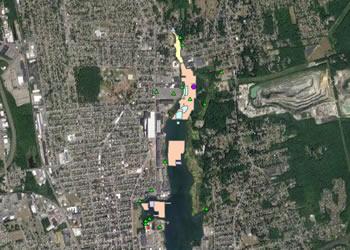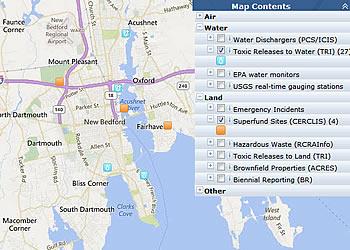EPA Cleanups: Communities around New Bedford Harbor
- Why is EPA cleaning up the harbor?
- What's being done about the pollution?
- VIDEOS: See the cleanup in action
Watch how the cleanup works | History of Harbor Pollution
EPA Cleanup Photos
Harbor Cleanup Map
 Map of Cleanup Areas
Map of Cleanup AreasSee map of areas dredged to date (PDF) (1 pg, 354 K, About PDF)
Other Local EPA Projects and Programs
- Aerovox Mill Demolition, New Bedford, MA
The Aerovox Mill was an electronics manufacturing facility that used polychlorinated biphenyls (PCBs) from 1940 to about 1977 and contributed a significant amount of the PCB waste that is present in New Bedford Harbor today. Formerly located at 740 Belleville Avenue in New Bedford, Massachusetts, the 450,000 sq. ft. building was safely demolished in 2011. A paved cap now remains on approximately 10 acres of industrial-zoned land beside the Acushnet River. Soil and groundwater at the site remain heavily contaminated with PCBs and other industrial chemicals.
- Atlas Tack, Fairhaven, MA
The Atlas Tack facility was built in 1901 in Fairhaven, MA and historically manufactured wire tacks, steel nails, rivets, bolts, shoe eyelets and similar items. Facility operations included electroplating, acid-washing, enameling, and painting until 1985. Wastes were disposed of on the grounds, in adjacent wetlands and into an on-site lagoon. High levels of heavy metals, cyanide, PCBs, volatile organic compounds, pesticides, and other contaminants impacted area groundwater and surface waters, in addition to the site soil, sediment and portions of the former buildings.
The $21 million, two year EPA cleanup was completed in 2007 and removed about 108,129 tons of contaminated material. The upland portion of the site was backfilled and seeded, and the wetlands were restored to pre-industrial conditions with additional native freshwater wetland enhancements. The Atlas site now meets commercial/industrial cleanup standards and remains mostly private property. Although the cleanup has been completed, EPA and MassDEP continue to conduct environmental monitoring and maintenance activities. Groundwater monitoring will continue until the ecologically-based cleanup goals are met and land use restrictions will be placed on the site to help ensure that the cleanup remains protective.
- Brownfields Projects and Grant Opportunities
The City of New Bedford has received over $2.9 million in EPA Brownfields funding since 1997 to assess and cleanup Brownfields properties within the City and to conduct job training programs. They have assessed over 14 properties, cleaned up four properties and have trained 79 workers.
- Environmental Justice Program and Grants in New England
All residents of New England are entitled to clean air, land and water in their homes, schools, offices and outdoor environments. The EPA Region 1's (New England) Environmental Justice program works to protect all people, regardless of race, color, national origin or income, from environmental harms and risks, and to involve all citizens in making decisions that affect the environment in which they live, work and play. Minority and low-income communities are often disproportionately exposed to the impacts of pollution. EPA New England's Environmental Justice Program is designed to work to greater protect these communities.
In New Bedford, EPA Region New England's EJ program convened several meetings in late 2009 and early 2010 to provide opportunities to engage the community around environmental justice issues. As a result, New Bedford continues to be a priority community for the EJ program.
- Parker Street Assessment and Cleanup, New Bedford, MA
The Parker Street Waste Site has been defined to include about 122 acres in northwestern New Bedford, Massachusetts. Through the Superfund removal program, EPA began working with the Massachusetts Department of Environmental Protection in 2009 to define the boundaries of the Parker Street Waste Site. In April of 2010, EPA's removal program began taking soil samples to determine the extent of contamination and to determine whether a removal action was necessary. Hazardous substances were identified on some properties, triggering the need to remove contaminated soils. Removal work began in November of 2010 and EPA completed the residential removal actions in the fall of 2012.
For activity updates and more information about Parker Street »
- Re-Solve Superfund Site, Dartmouth, MA
From 1956 to 1980, the Re-Solve, Inc., site in North Dartmouth, MA was a chemical waste reclamation facility and became a Superfund Site in 1983 after extensive PCBs and volatile organic compounds (VOCs) were discovered in the soil and groundwater. By 1998, all debris and buildings were removed, contaminated soil was treated, 1 acre of wetlands restored and a groundwater pump and treatment system was installed that continues to prevent contamination from impacting nearby residents.
Since 1988, the Massachusetts Department of Public Health (MassDPH) has kept a catch and release fishing advisory in effect for the nearby Cornell Pond and Copicut River due to PCBs in fish from the site. Since 1998, the surrounding community has participated in the Cornell Pond Fishing Derby, which supports EPA's annual fish monitoring program. The first twenty local fishermen to sign up compete for the biggest catch and help EPA collect samples to assess environmental progress.
Annual Cornell Pond Derby Fact Sheets
Once a cleanup is underway at a Superfund Site, EPA requires a thorough review every 5 years to ensure the remedy is working as expected and confirm there are no new site related health concerns. Re-Solve's most recent Five Year Review was completed in 2013.
- Sullivan's Ledge Landfill, New Bedford, MA
The 12-acre Sullivan's Ledge site in northwestern New Bedford operated as a quarry until about 1932. Between the 1940s and the 1970s, local industries used the quarry pits and adjacent areas for disposal of hazardous material and other wastes. After its listing as an EPA Superfund Site, contaminated soil and sediment were consolidated and capped under an impermeable cover over the old quarry site on Hatheway Road. In addition, a groundwater treatment plant was installed to reduce the migration of contaminated groundwater from the Site. Wetlands impacted by the cleanup work have been repaired. The former quarry cap and surrounding fence prevents exposure to passersby.
Current activities include the routine operation and maintenance of the groundwater treatment plant, the control of landfill gas from the site landfill, and the continued restoration of the wetlands impacted by the cleanup. Operation and maintenance of the site remedy is being conducted by the responsible parties in conjunction with the City of New Bedford under EPA oversight.
The site's most recent Five Year Review was completed in 2013.




